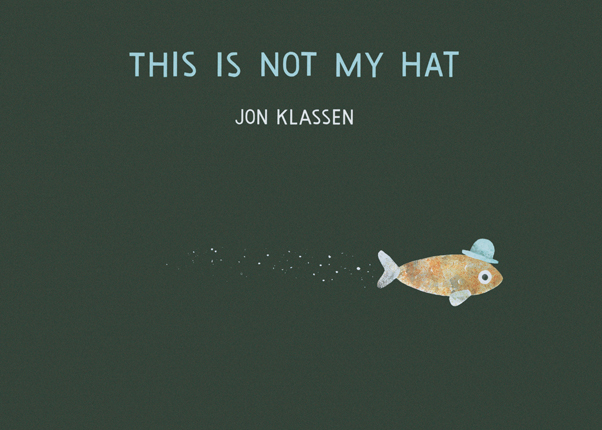| This is not my hat Author: Klassen, Jon | ||
| Price: $23.78 | ||
Summary:
A fish has stolen a hat and he'll probably get away with it. Or will he?![]() Download a Teacher's Guide
Download a Teacher's Guide
Video Preview:
| Accelerated Reader Information: Interest Level: LG Reading Level: 1.60 Points: .5 Quiz: 154574 |
Awards:
Caldecott Medal, 2013
Common Core Standards
Grade 2 → Reading → RL Reading Literature → 2.RL Craft & Structure
Reviews:
Kirkus Reviews (+) (09/15/12)
School Library Journal (+) (00/09/12)
Booklist (+) (08/01/12)
The Bulletin of the Center for Children's Books (+) (11/12)
The Hornbook (+) (00/09/12)
Full Text Reviews:
Booklist - 08/01/2012 *Starred Review* Klassen’s authorial debut, I Want My Hat Back (2011), became one of the surprise picture-book hits of the year. This follow-up is really only related in its hat-theft theme, animal characters, deadpan humor, and a suggestively dark conclusion. Which might seem like everything, but whereas the first book featured light sleuthing by a semi-dopey bear looking to find his lost lid, this is a similar story from a fishy absconder’s point of view. “This hat is not mine. I just stole it,” claims a minnow darting through the deep-sea black. He tells how he lifted it from a bigger fish. At each stage, the minnow reassures himself that he’s gotten away with his perfect crime. We see it ain’t so, as the big fish trolls along right behind him, right down to the minnow’s final, prophetic double entendre: “Nobody will ever find me.” Once again, the simple, dramatic tension and macabre humor mesh splendidly with Klassen’s knack for tiny, telling details and knockout page turns. Who knew hat thievery was such a bottomless well? HIGH-DEMAND BACKSTORY: Klassen’s debut was a #1 New York Times best-seller and Geisel Honor Book. The publisher is rolling out a 15-city tour and pulling out all the publicity stops in support of this release. - Copyright 2012 Booklist.
Bulletin for the Center... - 11/01/2012 In Klassen’s brilliant I Want My Hat Back (BCCB 11/11), a large and disgruntled bear searches for his hat, stolen from him by an unrepentant rabbit. Here Klassen flips the storyline and presents a thief’s-eye view of a hat theft, as the tiny fish narrator confides on the opening pages, “This is not my hat. I just stole it.” He goes on to explain that he purloined it from a much bigger fish who was asleep, then proceeds to helpfully describe where he’s now headed (“I am going where the plants grow big and tall and close together”) and why he took it: “I know it does not belong to me. But I am going to keep it. It was too small for him anyway. It fits me just right.” What the tiny fish doesn’t know (and what Klassen cleverly portrays through the illustrations) is that the bigger fish has awakened, has overheard the little fish’s narration, and is now after him. As the tiny fish thief heads into the thicket of plants, the larger fish silently tails him. While the little bowler bandit confidently claims from offstage, “Nobody will ever find me,” the larger fish is shown slipping into the plants as well. A page turn reveals . . . nothing but the thickly growing plants. What’s going on in there? The following spread shows only the tail of the larger fish as he heads out of the plants and off the page, but the final spread presents the satisfying answer as the big fish is now soundly asleep with the minuscule hat perched atop his giant head and the tiny fish nowhere to be seen. This is picture-book storytelling at its best, as Klassen’s minimalist illustrations, rendered digitally and in Chinese ink, are not only gorgeous but also absolutely integral to the understanding of the story’s plot. There’s a hint of Leo Lionni’s art in Klassen’s illustrations, as the splotchy gray-brown fish float in an inky matte black sea sprinkled with Matisse-like water plants in pale neutral tones. The hat—a tiny derby in the palest of blues—and a wide-eyed crab in muted reds provide some notes of color, and spatters of white bubbles accent each fish. Subtle details add drama and humor, with the larger fish’s increasing umbrage adroitly depicted through the simple but highly effective change of his eye shape from circle to narrowed oval; the crab is not only witness but informant, mutely pointing a claw in the direction taken by the hat thief. Page layout effectively paces the story: wide full spreads that make the most of the book’s long rectangular trim size and sport the text in surtitles above the visuals are interspersed with more staccato spreads of art opposite text page; the climactic events speed into a suspenseful glide in a sequence of textless full spreads. The naughty fish thief and his comeuppance, the stunning pictures, and the thrill of knowing more than the narrator will make this appealing to kids of a wide range of ages and interests. The book is also remarkably useful, as the text-picture relationship (and textually unexplained disappearance of the tiny fish) is perfect for teaching about inference, while the tightly focused art, simple vocabulary, and short sentences printed in large type make this perfect for novice readers as well. This is, quite simply, an outstanding book—and that ain’t no fish tale. (See p. 151 for publication information.) Jeannette Hulick, Reviewer - Copyright 2012 The Board of Trustees of the University of Illinois.



